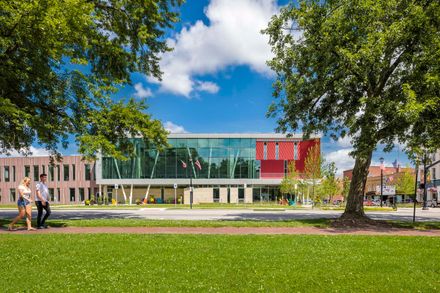
Hotel At Oberlin
ARCHITECTS
Solomon Cordwell Buenz
LEAD ARCHITECTS
SCB
INTERIOR DESIGN
The Gettys Group, Inc.
STRUCTURAL
Halvorson And Partners, Inc.
MEP
Imeg Corp.
LANDSCAPE AND CIVIL
Neff & Associates
ART INSTALLATION AND LANDSCAPE DESIGN
Maya Lin Studio
ENVIRONMENTAL ENGINEER
Transsolar Kilma Engineering
MANUFACTURERS
Draper, Rieder Group, Cascadia, Innovation Glass, Kolbe, ROCKWOOL
CONTRACTOR
Am Higley
PHOTOGRAPHS
Brad Feinknopf
AREA
51152 ft²
YEAR
2016
LOCATION
Oberlin, United States
CATEGORY
Hotels, Sustainability
Text description provided by architect.
The Hotel at Oberlin is the major program element of the Peter B. Lewis Gateway Center, a 104,000-square-foot mixed-use building thatreimagines the campus hotel typology to create a focal point that unites the city and the college.
The high-tech and highly sustainable center visually signals the technologically and ecologically progressive nature of the Green Arts District.
Through a groundbreaking mix of sustainable strategies and technologies, it is on track to become LEED Platinum certified—just the fifth new hospitality project in the country to achieve this standard.
As measured by Energy Use Intensity, the building will be within the top ranking of commercial structures in North America, using 55 percent less energy than comparable buildings.
Designed by Solomon Cordwell Buenz (SCB) in collaboration with Transsolar Climate Engineers, the Gateway Center is a model for high performance building design and whole-systems thinking.
Rather than use a traditional air conditioning system that circulates hot or cold air to regulate the ambient air temperature, the hotel utilizes a radiant heating and cooling system.
It is the first hotel in the country to utilize this passive system, which relies on surface temperatures within the building to heat and cool interior spaces.
Each guest room contains a radiant ceiling panel and a ceiling fan, which helps increase the cooling performance of the system by moving air across the panel.
The radiant heating and cooling system is supported by a geothermal field composed of 48 405-foot- deep wells. Photovoltaic panels supplement power production for the hotel.
Oberlin’s on-campus ten-acre, 2.27-megawatt solar array can generate approximately three million kilowatts of electricity annually.
Rainwater is harvested and used for landscape irrigation, while on-site bio-retention basins slowly filter storm water. A high-performance facade and exterior automatic solar shading devices reduce heat gain.
The interior design for the project uses natural, salvaged, or recycled materials and sourced 50% of building materials from within 500 miles from Oberlin.
Whenever possible, materials with low volatile organic compounds (VOC) were specified to minimize off-gassing and improve interior air quality.
As part of the Green Arts District, art was obviously to play a major role in the project’s design. Ohio native Maya Lin, designer of the Vietnam Veterans Memorial in Washington, D.C., created a three-part installation called “An Ecological Primer: A Landscape in 3 Parts” that spans the hotel’s lobby and grounds.
The Hotel at Oberlin takes a proactive approach to educating guests on how they can impact building performance and participate in conservation measures. Guest rooms are fitted with indicator lights that show when outdoor conditions are suitable for opening the windows.
When the windows are open, sensors automatically shut off the radiant panels and ventilation system. Educational signage and an information kiosk that displays energy consumption data are presented in an easy-to-understand manner, making sustainability education part of the guest experience.

























